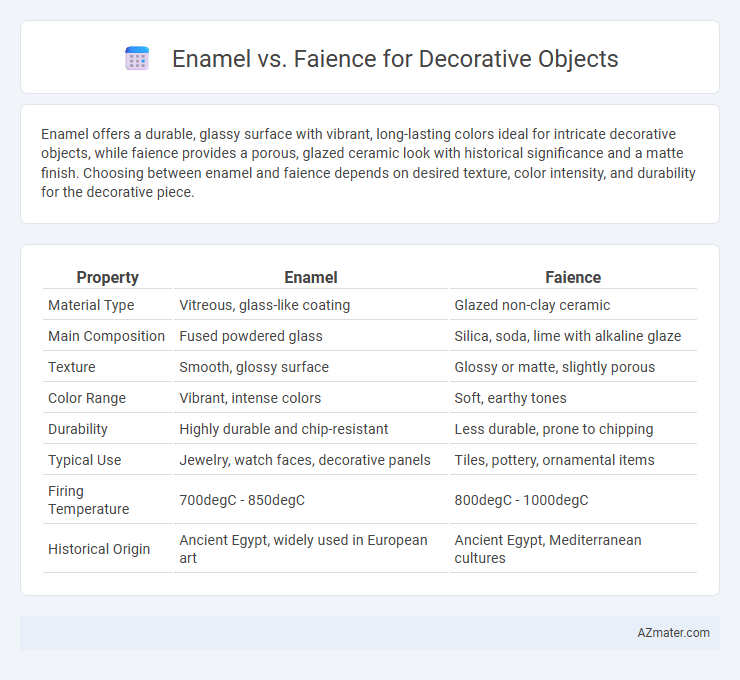Enamel offers a durable, glassy surface with vibrant, long-lasting colors ideal for intricate decorative objects, while faience provides a porous, glazed ceramic look with historical significance and a matte finish. Choosing between enamel and faience depends on desired texture, color intensity, and durability for the decorative piece.
Table of Comparison
| Property | Enamel | Faience |
|---|---|---|
| Material Type | Vitreous, glass-like coating | Glazed non-clay ceramic |
| Main Composition | Fused powdered glass | Silica, soda, lime with alkaline glaze |
| Texture | Smooth, glossy surface | Glossy or matte, slightly porous |
| Color Range | Vibrant, intense colors | Soft, earthy tones |
| Durability | Highly durable and chip-resistant | Less durable, prone to chipping |
| Typical Use | Jewelry, watch faces, decorative panels | Tiles, pottery, ornamental items |
| Firing Temperature | 700degC - 850degC | 800degC - 1000degC |
| Historical Origin | Ancient Egypt, widely used in European art | Ancient Egypt, Mediterranean cultures |
Introduction to Enamel and Faience
Enamel is a glassy, vitrified coating fused to metal or ceramic surfaces through high-temperature firing, known for its durability and vibrant colors in decorative objects. Faience, a type of glazed non-clay ceramic, features a porous body covered with a bright, opaque glaze made primarily from silica and alkali, widely used in ancient and traditional art. Both materials serve decorative purposes, but enamel offers a harder, more glossy finish, while faience is prized for its textured, matte surface.
Historical Overview of Enamel and Faience
Enamel, originating in ancient Egypt and widely perfected during the Byzantine and Renaissance periods, is a durable glassy substance fused to metal surfaces for vibrant decorative effects. Faience, dating back to the Neolithic era and flourishing in ancient Egypt and the Near East, is a glazed non-clay ceramic characterized by its bright blue-green hues achieved through a quartz-based paste and silica glaze. Both materials have held significant cultural and artistic value, with enamel favored for intricate metalwork and faience prized for its affordability and striking coloration in ornamental artifacts.
Material Composition: Enamel vs Faience
Enamel consists primarily of powdered glass fused to a metal substrate through high-temperature firing, creating a durable, glossy surface that resists wear and corrosion. Faience is a non-clay ceramic material composed of ground quartz or sand mixed with alkali and lime, then coated with a vitreous glaze that gives it a bright, often opaque finish. While enamel offers superior hardness and metallic adhesion, faience provides a lightweight, porous base with vivid color possibilities due to its mineral composition and glazing process.
Manufacturing Techniques Compared
Enamel manufacturing involves fusing powdered glass to a metal substrate through high-temperature firing, creating a smooth, durable, and glossy surface ideal for intricate decorative details. Faience production uses a ceramic technique where a quartz or sand-based paste is glazed and fired at lower temperatures, resulting in a porous, opaque, and often brightly colored finish commonly found in ancient artifacts. The key difference lies in enamel's metallic base and higher firing temperatures for permanence versus faience's ceramic composition and glaze application for vibrant but less durable decoration.
Aesthetic Qualities and Color Range
Enamel offers a rich, glossy finish with vibrant, durable colors that enhance decorative objects through a smooth, glass-like surface and high translucency. Faience provides a matte, rustic texture with earthy tones and a subtle sheen that evokes an antique, handcrafted aesthetic. The color range in enamel spans from intense blues and reds to bright yellows and greens, while faience typically showcases softer, muted hues such as turquoise, ochre, and soft greens.
Durability and Longevity
Enamel offers superior durability due to its glassy coating that resists scratches, fading, and environmental damage, making it ideal for long-lasting decorative objects. Faience, a type of glazed ceramic, is more prone to chipping and wear over time because of its porous composition and softer glaze. For longevity in decorative objects, enamel's robust, non-porous surface provides enhanced resistance to moisture and temperature fluctuations compared to faience.
Artistic Applications and Uses
Enamel offers vibrant, durable colors ideal for intricate metalwork in jewelry and ornamental objects, providing a glossy, glass-like finish that enhances artistic detail. Faience, a sintered-quartz ceramic, is prized in decorative arts for its matte or semi-gloss surface and rich historical association with ancient Egyptian and Mediterranean craftsmanship. Artists prefer enamel for precision and brilliance in small-scale applications, while faience suits larger sculptural pieces requiring textured, earthy aesthetics.
Cultural Significance in Decorative Arts
Enamel and faience both hold profound cultural significance in decorative arts, with enamel renowned for its vibrant, durable surface that has been cherished in European and Asian traditions for centuries. Faience, a tin-glazed pottery, carries historical importance in Mediterranean cultures, particularly in ancient Egypt and the Islamic world, where it symbolized purity and immortality through its lustrous, opaque finish. The choice between enamel and faience reflects distinct cultural narratives and technological advancements that have shaped decorative objects' aesthetic and symbolic roles worldwide.
Collectibility and Market Value
Enamel decorative objects often hold higher market value due to their intricate craftsmanship and durability, appealing strongly to collectors seeking long-lasting quality and vibrant finishes. Faience pieces, while prized for their historical significance and unique glazed ceramic textures, tend to attract niche collectors interested in antique or ethnographic items, often resulting in moderate but stable market demand. The collectibility of enamel versus faience largely depends on provenance, rarity, and condition, with enamel objects generally commanding higher prices in contemporary art and luxury decor markets.
Choosing Between Enamel and Faience for Decorative Objects
Choosing between enamel and faience for decorative objects depends on durability, appearance, and historical significance. Enamel offers vibrant colors and a smooth, glass-like finish that resists fading and corrosion, ideal for ornate jewelry and metalwork. Faience, a glazed ceramic material, provides a unique matte texture with cultural heritage value, commonly featured in ancient Egyptian artifacts and decorative tiles.

Infographic: Enamel vs Faience for Decorative Object
 azmater.com
azmater.com